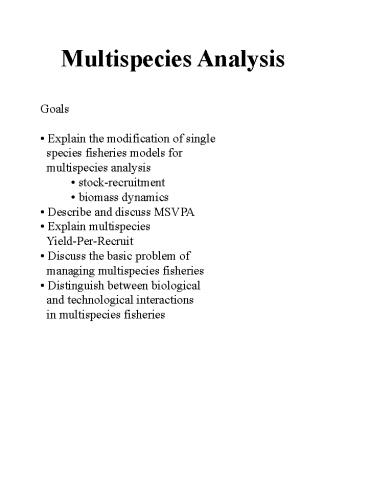Multispecies Analysis - PowerPoint PPT Presentation
1 / 18
Title:
Multispecies Analysis
Description:
Yi = Dit Fipit Wit. Mit Fipit. t. i = species. t = age, t = tr. D = Number ... Dit = Ni,t 1 - Ni,t = Nit (1 - e - ( Eqipit Mit ) ) Also need. numbers dying ... – PowerPoint PPT presentation
Number of Views:29
Avg rating:3.0/5.0
Title: Multispecies Analysis
1
Multispecies Analysis
- Goals
- Explain the modification of single species
fisheries models for multispecies analysis - stock-recruitment
- biomass dynamics
- Describe and discuss MSVPA
- Explain multispecies Yield-Per-Recruit
- Discuss the basic problem of managing
multispecies fisheries - Distinguish between biological and
technological interactions in multispecies
fisheries
2
Aquatic Ecosystems
3
Multispecies Stock and Recruitment The Ricker
Model
- two interacting species
- one is of interest
- the second negatively affects the recruitment
of the first - competition
- predation
- new
- variable X stock of 2nd
- parameter c effect
R S e a-bS-cX
log(R/S) a - bS - cX error
4
Cod and Herring Recruitment
- suggests instantaneous mortality of herring
due to cod 0.75 - several 100s of juvenile herring per year
- however, high Mcould be spurious
- NEED CONTRAST (S X)
- here, estimate agrees with cod gut content
analysis
5
General Multispecies Ricker
R S e a-bS- ? ci Xi
for i 1 to n additional species
Similar derivations possible withother
Stock-Recruitment models.
What is a potential problem with this
approach? What was needed to provide meaningful
results with one additional species (X) ?
6
Multispecies Biomass Dynamics
- Two approaches
- model complexity
- simplification (data aggregation)
Model Complexity
Bt1 Bt r Bt ( 1 - Bt / k - c Xt) - Ct
X as biomass, c as effect parameter
Ct Bt Et q, as previously
(Ut1/Ut) - 1 r - (r / kq)Ut - r c Xt - qEt
NEED good contrast between U, X,and E
7
General Multispecies Biomass Dynamics Model
Bi,t1 Bi,t r Bi,t ( 1 - ? bi,jBj,t) - Ct
bi,j the interaction coefficient between
species i and j (community matrix)
- Problems with Parameter Estimation?
- available data (indices only)
- thus need to estimate q
- number of parameters
- contrast
8
Multispecies VPA
- Extension of VPA to include
- Natural mortality due to predation among
fished species
- Require
- usual catch-at-age data
- several species
- predation relationships
- from gut analysis?
- proportion total diet from VPA species
- preferences
- estimate (or assumption) on non-predatory M
9
Equations of MSVPA
Uj NjRjPj
j cohort N number R annual ration /
individual (wt.) P proportion of ration from
species in MSVPA U amount consumed by
cohort (wt.)
Eij (Uj Aij) / Wi
Eij i-th cohort eaten by j-th Aij
preference matrix, defined as proportion of
i-th in j-ths diet Wi weight of individual in
i-th
10
Cohort Equations
Ni,t Ni1,t1 eM (Ci,t Ei,t)eM/2
M non-predatory natural mortality C
catch E sum of all i individuals eaten by
other cohorts
If M0
Ni,t Ni1,t1 Ci,t Ei,t
- Must solve iteratively due to E
- solution of many cohorts is linked
11
From the North Sea
- Some considerations
- High data requirements
- A matrix must be either
- independent of abundance
- or
- measured each year
- What if M dominated by abiotic factors?
12
Aggregated Production Models
- Aggregated Biomass Dynamics
- Simplify Problem By Assuming
- Biomass is Biomass
- at least for some group of spp.
- Especially in tropical fisheries
- biomass dynamics unclear for single species
data - better fit with aggregated data
13
Multispecies Yield-Per-Recruit
- Extension of Original Yield-Per-Recruit
- single species model
- integrated several models
- recruitment, growth, M, F
- dynamic pool
- age-structured
- avoid growth overfishing
- maximize Yield/Recruit
- specific tr and F
- Yield/Recruit Number Dying
- X Proportion of Death
- From Fishing X Weight
- Summed Across All Ages
- Beyond Recruitment
14
Multispecies Equations
i species t age, t gt tr D Number
Dying F M as usual p fraction
recruited W weight at age
Remember (by species i) Fi E qi so ...
15
- Also need
- numbers dying
- initial cohort size
Ni,t1 Nit e - ( Eqipit Mit )
Dit Ni,t1 - Ni,t Nit (1 - e - ( Eqipit
Mit ) )
- Initial Ns from other sources
- surveys?
- Aggregated Yield is Yield
16
The Aggregative Approach
- as in Biomass, MSYPR
- assume
- biomass is biomass
- size tropic relationships remain in
balance - seems to work sometimes
- Why do it?
- fishery occurs that way
- esp. tropical trawls
- technological interactions
- impossible to separate harvest by species
- lack of species specific data
- may reflect some biological truth (wishful,
but interesting)
17
- BUT there are problems even if true
- common harvest rate
- based on strong and weak stocks
- weaker stocks may go extinct
- always get greater return from individual
harvests - not always possible
18
Management Options for Multispecies Fisheries
- Detailed model of interactions
- many parameters
- very expensive, if possible
- Manage weakest stock
- forgo production
- Manage for average stock
- constant escapement
- constant harvest
- possible local extinctions
- All strategies questionable
- due to complexity
- Direct Empiricism
- try it out, adapt
- set clear criteria for success/failure
- harvest, extinctions, etc.































